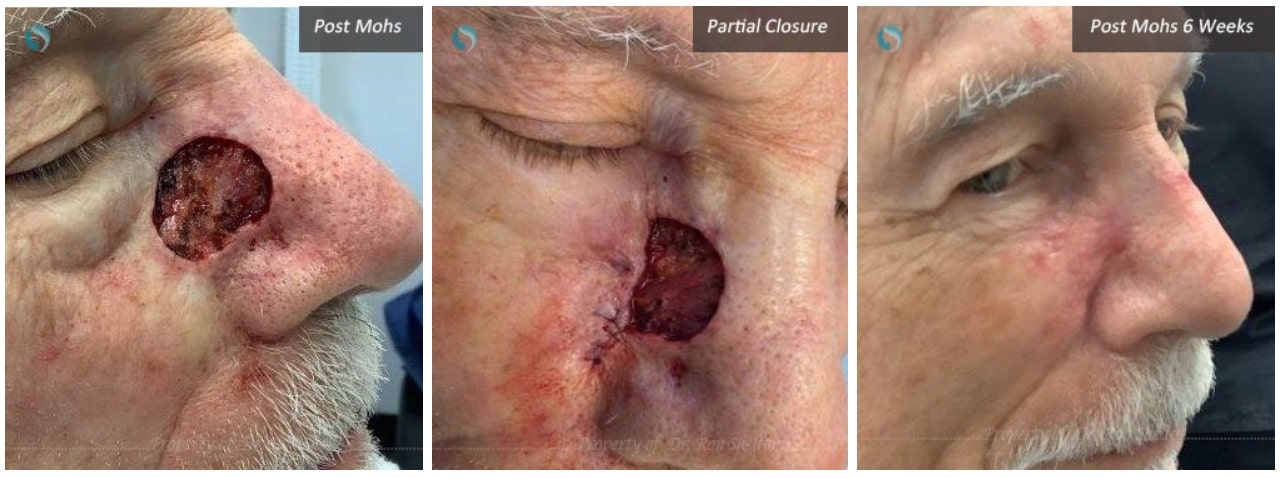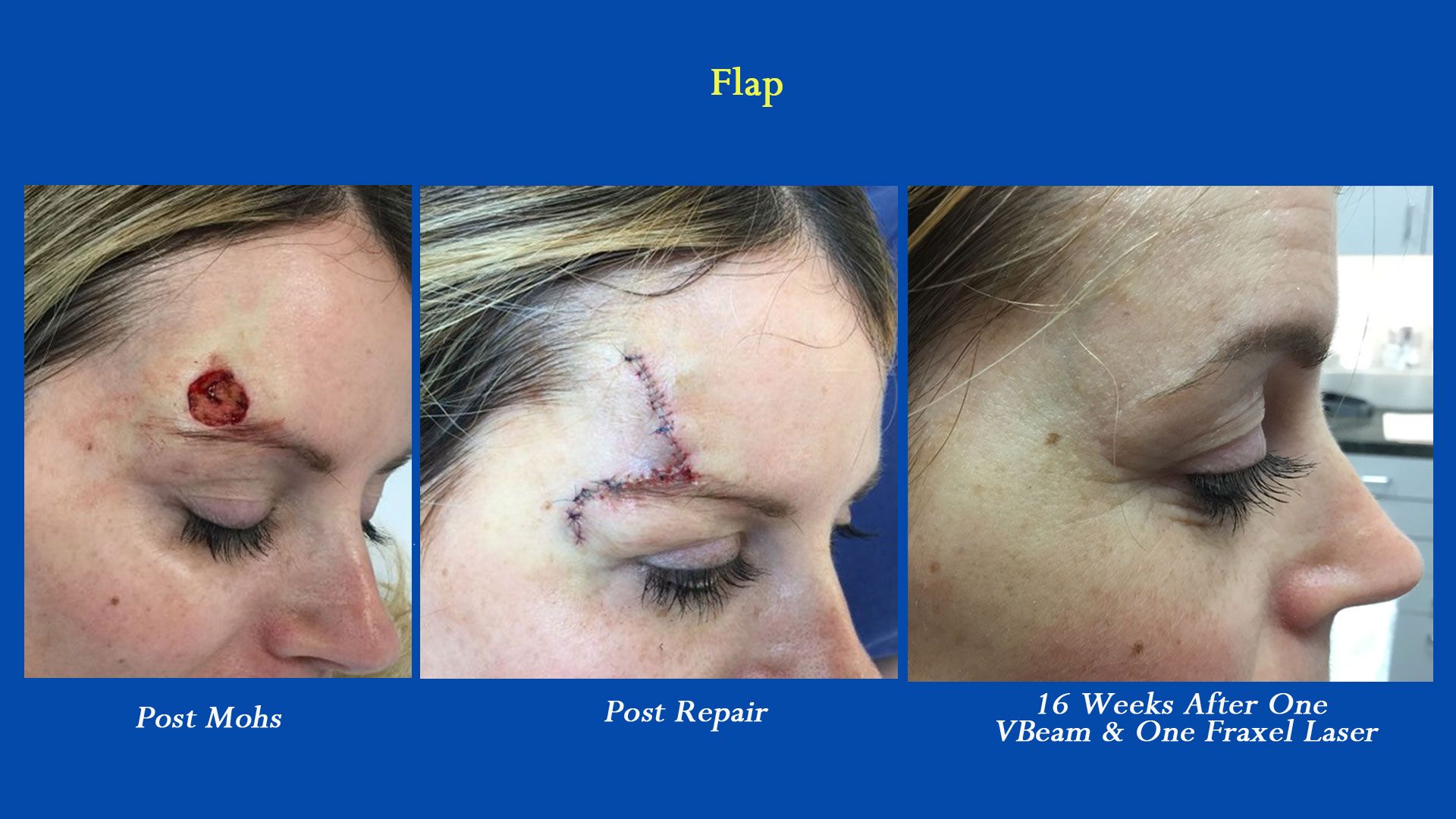As seen in Dr. Shelton's photo gallery of Mohs micrographic surgery and his reconstruction, there are numerous ways to repair a defect once the tumor is removed. Dr. Shelton's 30 years' experience and training and learning of Mohs Skin Cancer Surgery from the masters in his field as well as using his own initiative, excellent knowledge of anatomy, good sense of physics and his artistic sense enables him to realize how the different methods of reconstructing the same defect will result in various end results.
Click here to see Mohs photos from Dr. Shelton of many different locations >>
Unlike some surgeons whose mission is to close any defect so that it's done, Dr. Shelton considers many alternatives to achieve the best end result, the result his patient will live with for the rest of their life. There are also different preferences that his patients may have; some focusing on getting back to a normal life as quickly as possible and not caring much about the scar while others want to have the least noticeable scar. Dr. Shelton is not only a good listener, but he gets to understand his patients feelings quickly even during the first visit. He reads them well and then communicates with them taking his time to discuss the process and explain how the wound and scar will look during the weeks and months post operatively.
Mohs defects are like snowflakes, Dr. Shelton often says; no two wounds are alike.
Dr. Shelton takes into account the following:
- The location of the defect after the Mohs surgery is completed,
- Proximity to loose margins that should not be moved during a closure of a nearby wound such as an eyelid or lip,
- the tension, color and texture of the surrounding skin.
- Can the closure be accomplished while working only within that cosmetic unit or will skin need to be recruited from a nearby area that will change the boundary or junction line between the two cosmetic units?
- Will the repair require more than one surgery to trim redundant tissue that can't be safely removed at the time of the first surgery without compromising the blood supply of the skin "flap."
- Should the defect be patched with a skin graft taken from another area, and if so, which donor area would look the best and heal with the least noticeable scar?
- Should the wound be allowed to heal naturally and how long will it take in weeks or months, and what demands would that place on his patient? Is his patient able to take care of a wound or have available family or an aid able to do so?
- Can his patient return for several follow-up visits?
- Is the wound best closed by bringing both sides of the adjacent skin together and what puckering would this create and how best to remove those puckers placing them in which preexisting creases?
- Might the wound be best dealt with by partially closing it, thereby shrinking its size, and enabling easier wound care for the patient, less bleeding and a smaller scar?
The wounds that encompass more than one cosmetic unit may be dealt with better by breaking up the cosmetic units and dealing with them individually. Rather than patching a large defect involving the cheek and nose with a skin graft that will look out of place, or closing a wound completely that may place a scar in the middle of a cosmetic unit, the following case shows how Dr. Shelton approached a wound that demonstrates involvement of both cheek and the side of the nose. In the case shown above it was determined that patching the hole with a skin graft would leave a permanently obvious shiny thin whitish skin very different in appearance from the thick nasal skin with so many wide dark and deep pores. Utilizing the patient's healing ability the wound could heal looking better than a skin graft and obviate the need to do another surgery to harvest the patch of skin from somewhere else on the patient.
After thorough discussion with his patient and ensuring they were aware of the expected convalescent period and how to take care of the wound, the cheek was mobilized and closed up to the boundary junction between the nose and cheek recreating the line or fold that normally exists and the wound of the side of the nose was allowed to heal by itself. After six weeks of changing a dressing with ointment twice a day, the wound was completely healed. The minimal redness centrally will continue to fade naturally over several months. Some patients' skin is so fair that the redness can be persistent and that can easily be treated by a quick laser treatment during a follow-up office visit. Some incisions heal with a more visible groove because of the texture of the patient's skin especially in areas with more dense oil glands and pores. These creases can be improved with laser resurfacing that can be done a month after surgery or sometimes even sooner. "
Mohs procedure New York Educational Video

Click here to view Mohs procedure New York's Before & After Photo Gallery
Being the largest organ in the body, the skin is a major indicator of our general health. Current statistics indicate that skin cancer will affect as many as one in five people in our country at some point in their lives. The more UV exposure that occurs, the higher the risk is for concerning skin cancer. While the expert physicians in our comfortable Mid-town Manhattan medical practice often visit with patients who wish to improve the look of their skin, we also treat skin cancer using the latest proven techniques.
Mohs micrographic surgery in New York City is available for those who developed some types of skin cancer. Those who are facing a distressful diagnosis of non melanoma skin cancer such as Basal Cell and Squamous Cell Carcinomas have access to the latest state-of-the-art treatment performed by specifically trained physicians. Although results from Mohs micrographic surgery may vary from person to person, the technique through which skin cancer lesions are removed has the highest success rate of any alternative treatment and provides conservation or sparing of normal skin.
Physicians who have completed hundreds of hours of additional training in Mohs have the expertise to perform this delicate procedure with a great deal of precision, maximizing each patient's chances for a complete cure. With the technology utilized in the Mohs surgical procedure in NYC, the surgeon works to remove thin margins of skin around and under the tumor, one at a time, followed by immediate examination under a microscope. Skin cancers are treated without affecting or damaging the skin in the surrounding region.
The NYC Mohs surgical procedure provides the greatest amount of precision for the removal of skin cancers, and is ideal for highly visible areas on the body, including the face. By examining 100 percent of frozen section perimeters and deep margins, this technique provides the smallest defect to the skin possible. Dr. Shelton has fellowship training in this sub-specialty along with reconstruction, is a member of the prestigious American College of Mohs Surgery. and has published articles regarding Mohs surgery.
Skin cancer can be a very frightening diagnosis. We understand the feelings of anxiety that may develop for the skin cancer patient, and we are happy to discuss the various forms of treatment that will best suit immediate and long-term needs, both for aesthetics and for health. Dr. Shelton and his colleagues encourage patients to gain familiarity with their skin so that unusual changes may be detected right away. With early detection and treatment, there are excellent chances for cure.
Content updated: Nov 2021
What's next?
To learn more about Mohs Skin Cancer Surgery New York NY or to schedule your skin cancer screening in Dr. Shelton's Manhattan Mohs medical practice, call (212) 593-1818.
Related articles of Mohs Surgery in NYC
- Mohs Reconstruction NYC - Closure of Mohs surgery defects
- NYC Mohs to prevent Skin Cancers - How successful is NYC Mohs surgery?
- The life of a skin graft – Mohs procedure New York
- Is Mohs surgery the best option for skin cancer?
- What is Mohs skin cancer surgery - Mohs skin cancer surgery is an outpatient procedure performed in our modern dermatology facility.
- Mohs Micrographic Surgery in Midtown - Patients in NYC have Mohs micrographic surgery for skin cancer by Dr Ron Shelton and colleagues, at the Laser and Skin Surgery Center of New York.
- Best Mohs Surgery NYC / Mohs Surgery Recovery New York - Despite my sleeping with my head elevated, I awakened this morning with a lot of swelling under my left eye. I had Mohs surgery yesterday on my forehead near my hairline on the left side. Is this normal?
- Mohs for Skin Cancer New York - I am thirty-two years young and was just diagnosed with a skin cancer on the nose. It is not a melanoma fortunately but a squamous cell carcinoma. I don’t want a scar.
FAQ's on Mohs Surgery in NYC
- Mohs Surgery Scar New York - I had Mohs surgery on my nose two months ago and had a flap done to close the hole. I am happy but the flap appears slightly lumpy. What can be done to improve this?
- New York Mohs Surgery Recovery - I had a basal cell carcinoma removed from my nose, the tip, and my dermatologist only gave me a bandaid and ointment and said he would see me in four weeks. Should I not have had stitches?


